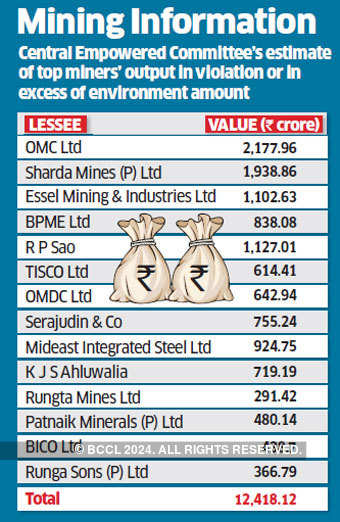BHUBANESWAR | Aug 04, 2017: The Supreme Court’s landmark order slapping heavy penalties that could amount to Rs 25,000 crore on companies that mined iron and manganese without proper clearances in Odisha can hit output in the months ahead, and trigger similar claims in mineralrich Jharkhand.
Tata Steel, SAIL and the Aditya Birla Group have mining operations in Odisha, which produces nearly half of India’s iron ore. These and other smaller groups have interests in 102 mines involved in what the court described as “a mining scandal of enormous proportions and one involving megabucks”.
The court, hearing a petition of NGO Common Cause, had ruled that any output in excess of, or without, environmental and forest clearances or approved mining plans is illegal, invoking provisions of the mining law that allows the state to recover the value of all such output.
Industry experts said the order could have wider repercussions, if Odisha decided to recover similar dues from chrome mines, or neighbouring Jharkhand decided to apply this order to its similarly errant mines. Jharkhand’s demand orders had been stayed by courts.

The total fine could exceed Rs 17,576 crore estimated by a panel ordered by the court. The biggest violator is state government’s Orissa Mining Corporation with Rs 2,177 crore worth produced illegally.
These figures do not include production in violation of the forest clearance, which is also a prerequisite in addition to environmental clearance. This will also attract a penalty of 100 % of average value sold and is estimated to be about Rs 8,000 crore. A lessee would be penalised for only one of the two lapses.
Most companies were still studying the verdict and declined comment for the time being, but some said the order was a killer blow. “Hang till death would have been better. Did we take the material and sell it on our own, without paying royalty and taxes on it, without assessment carried out on it? How does it become illegal mining?” asks Prashant Ahluwalia, MD of KJS Ahluwalia Group. His lease to a mine producing 5.6 mt ore annually is valid till January 2020, making him better placed to pay the penalty than many small miners whose leases also expire then.
Mideast Integrated Steel, a manufacturer of pig iron, owes the state Rs 924.75core for EC violations and excess production. Company’s CMD Rita Singh said: “We are in the manufacturing business, not of commercial mining. How does the government expect us to pay this?” Tata Steel and SAIL had not responded to mails seeking comments.
In private, mine owners said the penalty would definitely affect cash flow and impact production at least up to December. According to Eastern Zone Mining Association, there are 42 iron ore mines, 14 manganese and 14 chrome mines in operation currently.
The SC said mining could restart, subject to full payment of compensation and other dues, which left some miners wondering if they can carry on. “The court refers to ‘restart’ because this applies to non- working mines and not the ones allowed to operate again after the SC’s May 16, 2016 order,” said advocate Anand Varma whose client is an affected party. Director mines, Odisha, Deepak Mohanty, said “We haven’t taken any decision. I am yet to receive a certified copy of the order.”
Also uncertain, would be the fate of 84 leases SC wants surveyed again with satellite imagery and a joint team, and the report submitted to it. Any encroachment could lead to a cancellations of the lease, given the fact that the order says Section 21(1) be in the realm of criminal liability.
(Source: http://economictimes.indiatimes.com/)